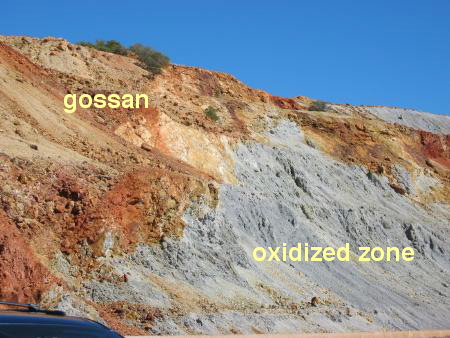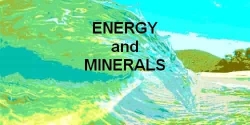Ore Deposit Terms
Ore Deposit Terms
Some Definitions of Common Terms Used in Describing Mineral Deposits
Bulk terms
Evaluation terms
Deposit terms
Shape terms
Structure terms
Texture terms

BULK ROCK TERMS
Ore
a mineral or minerals that can be mined and extracted from a rock at a profit.Gangue
Those minerals which occur with the ore minerals but which have no value, such as quartz, calcite or pyrite.EVALUATION TERMS
Mineralization / Mineralisation
A general term which usually refers to ore minerals but which often may refer to other metallic minerals such as pyrite.Waste
Rock which is not ore. Usually referred to that rock which has to be removed during the normal course of mining in order to get at the ore.Grade
The concentration of each ore metal in a rock sample, usually given as weight percent. If concentrations are extremely low, as with Au, Ag, Pt and others, the concentration may be given in grams per tonne (g/t). The average grade of an ore deposit is calculated, often employing very sophisticated statistical procedures, as an average of the grades of a very large number of samples collected from throughout the deposit.Cut-off
The cut-off grade is the arbitrarily defined lowest grade which will be mined from an ore ore deposit, and usually defines the boundary of the deposit. For example, if the average grade of a porphyry deposit is 0.5% Cu, the cut-off might be 0.2% Cu. any rock with a grade below 0.2% Cu would be waste.Reserves
The amount of ore in a given deposit, usually quoted as the number of tonnes available at a specific average grade.DEPOSIT TERMS
Host rock
The rock within which the ore deposit occurs.Country rock
The rock which surrounds the ore deposit. Also referred to as wall rock , in particular that rock on either side of a vein.Hydrothermal
Hot fluids, usually mainly water, sometimes acidic which may carry metals andother compounds in solution to the site of ore deposition or wall rock alteration.
Alteration
A change in the mineralogy of the country rock as a result of a chemical reaction with hydrothermal solutions. For example, mafic minerals such as hornblende or biotite may alter to chlorite and feldspars may alter to clay. An alteration zone describes rocks which have been altered to a specific group of secondary or alteration minerals, usually around the perimeter of a mineral deposit.Vein
A tabular deposit usually formed by deposition of ore and gangue minerals in open spaces within a fault or other structural environment.Replacement
A chemical process whereby hydrothermal fluids, passing through permeable rocks, react with the rocks to dissolve original minerals and relace them with oreand/or other gangue minerals.Massive sulphide
A stratiform (see below), usually lens-shaped mineral deposit consisting of at least 60% sulphide minerals.Skarn
A replacement of limestone (calcium carbonate) or other carbonate-rich rocks adjacent to an intrusive contact by calc-silicate minerals usually through the addition of Si and other elements.Epigenetic
Mineralization which has been deposited later than its immediate host rocks, for example a vein. The ore is younger than the host rocks.Syngenetic
Mineralization which has been deposited simultaneously with its host rocks, forexample placer deposits. The ore is the same age as the host rocks.Gossan
A rusty, surficial weathering zone which is caused by the oxidation of pyrite to produce secondary iron oxide minerals. Since pyrite is often associated with ore deposits, gossans can be a guide to ore.
SHAPE OF THE DEPOSIT TERMS
Concordant
Any geologic body, such as an ore deposit, which lies within or parallel to volcanic or sedimentary bedding and does not cut across the bedding structures. (Also conformable ).Discordant
A geologic body, such as a dike or vein, which cuts across primary rock structures such as bedding.Stratiform
A mineral deposit which occurs as a specific stratigraphic (or sedimentary) bed.Stratabound
A mineral deposit which occurs within a specific stratigraphic bed or horizon, but which does not comprise the entire bed.
STRUCTURAL TERMS
Footwall
The lower contact of an inclined vein, or the wall rock which lies on the lower side of a dipping vein.Hangingwall
The upper contact of an inclined vein.Fault
A planar feature or fracture zone along which displacement has occurred.Shear zone
A planar zone of weakness, similar to a fault, but consisting of several parallel displacement zones usually over a greater width than a single fault.Lode, shoot
All refer to mineralized zones within a fault or shear zone or a vein fissure, stringer structure.Breccia
Angular fragments of rock produced by movement along a fault or explosive igneous activity. The material which surrounds the fragments and cements them together is called matrix and might be vein minerals, igneous material or very fine rock fragments.
Stockwork
A large number of small, closely spaced veins, often with many different orientations, is referred to as a stockwork and sometimes as a stringer zone.Chimney
Also referred to as a pipe , this is a vertically oriented, cylindrical body, often a breccia, of vein or replacement mineralization.Manto
This is a horizontally oriented chimney-like structure, usually of replacement mineralization.
TEXTURAL TERMS
Banding
Banding may represent small scale sedimentary layering in a syngenetic deposit such as a massive sulphide or repeated pulses of mineralization in a vein.Crustiform banding
When minerals grow within a vein, they often grow inwards from the vein wall. Several layers of different types of minerals, representing different pulses of often aligned symmetrically away from the center of the vein.Comb structure
When minerals crystallize inwards from opposite walls of a vein, they often meet in the center to form an interdigitating pattern of crystals, usually quartz, which has an appearance similar to a rooster's comb.Vug
This is an open space or cavity, usually within a vein.Cockscomb
This is a crustiform banding when it surrounds breccia fragments.

